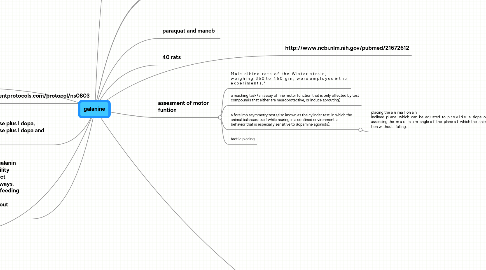galanine
by Monika Figura


1. New node
2. parkinson disease plus l dopa, parkinson disease plus l dopa and galanine
3. Galnon is a low-molecular weight galanin receptor ligand, with affinity towards the three galanin receptors in the micromolar range. Galnon is of interest as a drug candidate due to its stability and ability to pass the blood-brain barrier. Like galanin, galnon has also been shown to affect various physiological functions; however, occasionally galanin and galnon act in opposing ways. Since its introduction in 2002, galnon has been characterized to inhibit seizures, decrease feeding behaviour, diminish physical signs of opiate withdrawal and to alleviate heat-hyperalgesic response to partial sciatic nerve injury. In this review, we will summarize what is known about galnon to date
3.1. New node
4. http://www.currentprotocols.com/protocol/ns0803
5. PQ (10 mg/kg) and MB (30 mg/kg) - 6 month-old rat
6. The tests monitoring initiation time, stepping time, and step length were performed on a wooden ramp with a length of I. I m connected to the rats’ home cage. A smooth- surfaced table with a width of 0.9 m used for the test measuring adjusting steps All testing was performed during daytime. Handling and training. During the first 3 d the rats will be handled by the experimenter to become familiar with the experimenter’s grip. Dur- ing the subsequent l-2 d the rats are trained to run spontaneously up the ramp to the home cage. Food deprivation and food reward in the home cage were found to be unnecessary. The stepping test comprised two parts: first, the time to initiation of stepping by each forelimb, the step length, and the time required for the rat to cover a set distance along a ramp with each forelimb; and second the initiation of adjusting steps by each limb when the animal was moved sideways along the bench surface. Each test consisted of two tests per day for 3 consecutive days, and the mean of the six subtests were calculated. Initiation time, stepping time, and step length. The rat was held by the experimenter with one hand fixing the hindlimbs and slightly raising the hind part above the surface. The other hand fixed the forelimb not to be monitored. Time was measured until the rat initiated movement with the forelimb not fixed by the experimenter, using 180 set as break-off point. “Stepping time” was measured from initiation of movement until the rat reached the home cage; step length was cal- culated by dividing the length of the ramp by the number of steps required for the rat to run up the ramp. The sequence of testing was right paw testing followed by left paw testing, repeated twice. Adjusting steps. The rat was held in the same position as described above with one paw touching the table, and was then moved slowly sideways (5 set for 0.9 m) by the experimenter, first in the forehand and then in the backhand direction . The number of adjusting steps was counted for both paws in the backhand and forehand direc- tions of movement. The sequence of testing was right paw forehand and backhand adjusting stepping, followed by left paw forehand and backhand directions. The test was repeated twice each day.
7. The paradoxical preservation of galanin-like immunoreactivity, despite depletion of the activity of choline acetyltransferase, with which it is colocalized, is as yet unexplained. Recent studies have shown that galanin inhibits both acetylcholine release in the hippocampus and memory acquisition; therefore, preserved galanin may exacerbate the cholinergic and cognitive deficits that accompany dementia.
7.1. We are going to create the study with an investigated and control group. The investigated group will be provided with galanin and standard pharmacotherapy and the control group will be provided only with standard therapy. We are doing our research on humans.
8. http://www.ncbi.nlm.nih.gov/pubmed/21672612
9. 40 rats
10. neuroimagining method plus self assesment?
11. New node
12. assesment of motor funtion
12.1. M a l e a l b i n o r a t s o f t h e W i s t a r s t r a i n , w e i g h i n g 3 5 0 t o 4 5 0 g i n , w e r e e m p l o y e d in t h e e x p e r i m e n t s . *
12.2. a reaching task (an assay of fine motor function that is only affected by test compounds that either are neuroprotective, or induce sprouting)
12.3. a forelimb asymmetry test (also known as the cylinder test, in which the animal balances itself while rearing in a confined environment, a behavior that is especially sensitive to dopamine agonists);
12.3.1. placing the a n ima l on a n inclined pl ane which can be adjusted to p r o v i d e a slope o f varying gr ade , and then assessing the m a x i m u m angle o f the plane a t which the anima l can ma i n t a i n its posi- tion wi thout falling.
